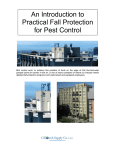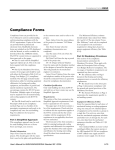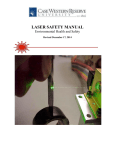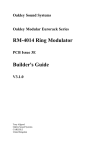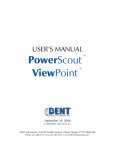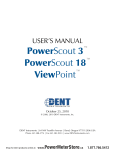Download Laser Standard Operating Procedure
Transcript
LASER SAFETY STANDARD OPERATING PROCEDURE Principle Investigator: Location: Class 4 Laser(s) Manufacturer & Model No. : LASER SAFETY CONTACTS Laser Safety Officer (lab): Phone: Maintenance/Repair: Phone: Yale Health Acute Care: 203-432-0123 EHS Emergency: 203-785-3555 1. LASER LAYOUT Attach a diagram of area layout as well as a digital photograph of all Class 4 lasers in the lab. 2. LASER SAFETY PROGRAM Responsibilities of the laser operator(s): Operator will ensure the safety of any personnel that might enter the room and will advise same of the status of the lasers and optics. this includes ensuring use of protective eyewear where required. The laser user is responsible for the safe of the laser(s) at all times. Incidents/accidents will be reported promptly to EHS. Laser Training Requirements: Part 1 of the training involves revision the Power Point presentation at http:// ehs.yale.edu/training/laser-safety-training. The Principal Investigator is responsible for providing instruction in the safe and appropriate use of the laser related to the specific research project, which constitutes Part 2 of the training. Laser Registration Requirements: EHS must be notified of the intent to purchase any class 3B or 4 lasers. Supply the manufacturer, model number, wavelengths, maximum power levels, beam profile, beam diameter and beam divergence. Personnel Protective Equipment Requirements: EHS will review the laser application/SOP. Typically protective eyewear will be required. Other protective equipment may be needed. This will be evaluated on a case by case basis. Users are responsible for purchasing and using prescribed protective equipment. Disposal Requirements: EHS requires proper disposal of all class 3B and 4 lasers. The laser may contain toxic or hazardous materials which require proper disposal. The laser must be “deactivated” prior to disposal. This may be performed by EHS, the user with EHS verification or a vendor. 3. OPERATING PROCEDURES (add additional information based on your application) Remove jewelry that might reflect beams. Obtain appropriate eyewear. Be certain it is of appropriate OD for the wavelength(s) in use. Turn on outside warning light. Inspect optical setup for recent changes/and or foreign objects. Verify that all personnel in lab are wearing approved eyewear. Issue verbal warning prior to starting laser. Insert key into laser controller. Proceed as per User Manual to obtain laser output. Comments 4. ALIGNMENT PROCEDURES Special alignment procedures: Use low power alignment laser, when possible. Use lowest possible energy setting. Survey area (with UV/IR viewer, if necessary) for reflections and confine such reflections to the optics table. Only after completing these procedures should the laser be increased to desired power and repetition rate. If more than one person is present, announce increase in power so that all present are aware of the change. Other tips: Allow only trained personnel to be present during alignment. Minimize the number of personnel present during the alignment. All present must wear appropriate eyewear. If possible, avoid using beam paths that are at sitting or standing eye level. Where feasible, use low power (class 2 or 3A) visible lasers to simulate the path of high power or invisible lasers. Where feasible, terminate laser beams and specular reflections on diffuse reflecting beam blocks. Use phosphor cards, IR viewers, video cameras or other display devices to locate invisible beams. Locate any specular reflections of the beam and block them as close to the source as possible. Whenever possible, reduce all high power laser beams to the minimum possible power. Use beam shutters to block high power beams any time they are not actually needed. Note: It is sometimes necessary to align, clean or otherwise maintain the internal components of a laser. If this is so for this laser, please attach a procedure for this process as an addendum. Describe how you will perform this work in a safe manner. If this is performed by a vendor, please indicate so. 5. CONTROL MEASURES LASER/LASER SYSTEM CONTROLS Click if valid CONTROL COMMENTS Entryway (door) Interlocks or controls Laser enclosure interlocks Laser housing interlocks Emergency STOP/Panic button Master switch (operated by key or code) Laser secured to base Beam stops/ beam attenuators Protective barriers Warning signs Reference to equipment manual Extra eyewear available Comments HAZARDS AND CONTROLS CHECKLIST Click if valid HAZARD Unenclosed beam/ access to direct or scattered light Laser at eye level of person sitting or standing Ultraviolet radiation/Blue light exposure Reflective material in beam path Hazardous materials/waste (dyes, solvents, other) Fumes/Vapors Electrical Capacitors Compressed gasses Fire Trip Hazard Comments CONTROL MEASURES IMPLEMENTED 6. PERSONNEL PROTECTIVE EQUIPMENT A. Eyewear - Please see the Laser Authorization from for Laser Protective Eyewear EHS Comments: Review your application and be certain you have selected eyewear of appropriate OD (optical density) for the wavelength and power levels. Users are responsible for selection, purchase and appropriate use of eyewear. B. Other protective equipment required within the Nominal Hazard Zone ITEM LOCATION USAGE CONDITION OPERATOR REVIEW: I have read and understood this procedure, its content, the EHS review below and attached addendum. I agree to follow this procedure each time I use the laser/laser system. Please be certain to read any addendums to this SOP prior to signing! Name Signature EHS review: Reviewed by (EHS) Name: Date: Title: Date





